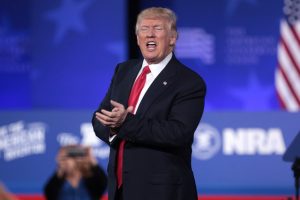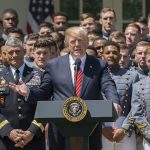by John Feffer
Conmen always keep up a patter. While they’re extracting the wallet from your pocket, they maintain a nonstop monologue so that you focus on their mouth and not what they’re doing with their hands.
Beware the voluble stranger.
Donald Trump has always been a talker. Even before he discovered Twitter, Trump was constantly bending people’s ears — about himself, his deals, his girlfriends. He even pretended to be other people on the phone in order to more credibly boast of his achievements: a ventriloquist who performed as his own dummy.
A few months before the 2016 elections, his former ghost writer Michael D’Antonio compared Trump to a card sharp: “His verbal gymnastics are intended to burnish his image, excite his followers, or tear down his competitors and critics. And like the three card monte dealer, Trump is prepared to bolt should he get caught in the game.”
Unfortunately Trump learned that the most successful conmen don’t bolt. When caught, they stand their ground and raise their (con) game. The short con is for losers.
In November 2016, enough Americans were distracted by Trump’s patter to put him into the White House. The Russian trolls that helped out through social media were just an expanded version of what Trump used to do by himself — create fake people to advance his cause. And when critics have tried to pin all this fakery on Trump himself, he has merely turned the tables by accusing his accusers of “fake news.” In a long con of this nature, the dupes are never quite sure what is real and what is sham.
Trump has brought this art of the con into foreign relations. He’s tried to pretend that he has an “America First” trade policy even as he grants concessions to China’s telecommunications giant ZTE (and just after Beijing awarded Ivanka a few more trademarks as well). He lambasted the 2003 decision to invade Iraq but is following the same pattern with Iran. He has promised a grand peace deal in the Middle East even as he jettisons the last pretense of America’s role of neutral arbiter and tightens his embrace of Israeli Prime Minister Benjamin Netanyahu.
But the most mystifying policy so far has been toward North Korea. In the last week, Trump has gone from eagerly anticipating a June 12 summit with North Korean leader Kim Jong Un to abruptly cancelling the summit to starting up the preparations again for the very same summit.
It looks and sounds like a classic shell game. Where’s the summit? Under this walnut shell? Wanna bet? Sorry, buddy, the summit disappeared. Ah, but wait — here it is, under this shell! Now, watch carefully as I move the shells one more time…
The least charitable interpretation of this behavior is that Trump is all sound and fury signifying nothing, which certainly characterizes his knowledge of all things Korean. The most charitable interpretation is that it’s all part of a sophisticated negotiating strategy of bluff and bluster.
Trump’s volatility, however, has an altogether different origin. It’s not just Trump’s patter that serves as a distraction. Trump himself is the distraction. While all eyes are focused on him, other forces are at work to make sure that the audience is fooled.
Why Did Trump Cancel?
Donald Trump wants a summit with Kim Jong Un. He wants the spectacle. He wants to demonstrate that he’s better than all the presidents who came before and failed to solve the nuclear crisis. He wants to prove that he, alone, can do diplomacy the right way (and so why not cut the State Department budget by a third?).
But ham actors are acutely aware of the prospect of being upstaged. Trump wants a Korean drama, but only one that he controls. As The Washington Post describes the scene in the White House on the eve of the cancellation:
Inside the White House residence, the first alarm sounded about 10 p.m. Wednesday when national security adviser John Bolton told Trump about North Korea’s public statement threatening a “nuclear-to-nuclear showdown” and mocking Vice President Pence as a “political dummy.”
Trump was dismayed by Pyongyang’s bellicose rhetoric, the same theatrics Trump often deploys against his adversaries. Bolton advised that the threatening language was a very bad sign, and the president told advisers he was concerned Kim was maneuvering to back out of the summit and make Americans look like desperate suitors, according to a person familiar with the conversations.
So Trump called it off first.
Pay attention to the key person in this account. It’s not Trump, who remains as always blithely unaware of what lies beneath the froth of current events. It’s John Bolton. Ostensibly he’s just the bearer of bad news in this story. But the national security advisor knew exactly how to play the president. He provided just the intelligence necessary to further Bolton’s own agenda: undermining the summit.
Searching for a scapegoat to blame for the summit going south, the administration seized on China. Trump asserted that Kim Jong Un had shifted his attitude toward the United States and the summit after a second discussion with Chinese leader Xi Jinping.
That’s the conman’s equivalent of snapping his fingers to divert your attention once again. China has consistently supported the summit and would love to see North Korea fully denuclearized. Moreover, North Korea didn’t fundamentally adjust its stance since Kim and Xi met on May 8. Indeed, the meeting came just before Secretary of State Mike Pompeo went for his second trip to Pyongyang and negotiated the release of three American detainees.
And, of course, North Korea went ahead as promised two weeks later with the destruction of its nuclear test site at Punggye-ri. In fact, it was demolishing this site at the very same time that Trump was preparing to send out his letter cancelling the summit. Talk about awkward!
For the world at large, Trump was clearly the unreliable flip-flopper, not Kim. And the key difference between the time Trump accepted the summit invitation and the moment he cancelled it was not Xi Jinping, but John Bolton. That’s part of the con. The Trump administration must somehow convince Americans and Koreans alike that this dangerous hawk can play a dove if called upon to do so.
On Again
The leaders of the two Koreas scrambled to meet again quickly in the wake of Trump’s cancellation letter. They met for a fourth inter-Korean summit to reaffirm their commitment to working level talks, to denuclearization, and to a U.S.-DPRK summit. In an even more promising development, North Korea is sending to the United States one of its top officials — Kim Yong Chol, a former head of military intelligence and reportedly Kim Jong Un’s right-hand man — to signal the importance of the meeting with Trump.
Eighteen years ago, North Korean General Jo Myong Rok made a similar trip to the United States to discuss the planned visit to Pyongyang by then-President Bill Clinton. The 2000 elections intervened, along with the surprise victory of George W. Bush. While the Supreme Court adjudicated the Florida vote, Clinton called off what might have been a historic turning point in U.S.-North Korean relations. Kim Yong Chol will meet with Pompeo to pick up on where Jo left off.
All of these moves do much to allay the American president’s chief concern — that the North Koreans will embarrass him personally by not showing up in Singapore. Trump, in turn, has indicated that the summit may well be on again, even for June 12, though it’s only a couple weeks away. In a tweet on Sunday, Trump wrote:
Our United States team has arrived in North Korea to make arrangements for the Summit between Kim Jong Un and myself. I truly believe North Korea has brilliant potential and will be a great economic and financial Nation one day. Kim Jong Un agrees with me on this. It will happen!
But what will happen? The summit? North Korea becoming a great economic nation one day? Or simply another move of the walnut shells?
What game is Trump playing exactly?
The Long Con
Let’s first put to rest two misconceptions surrounding this summit. The first is that Trump’s belligerent approach to North Korea is something new and has already yielded results. The second is that the diplomatic approach to North Korea obviously failed over the years, since the country now possesses nuclear weapons.
Trump’s threats and see-sawing attitude toward North Korea is nothing new. Bill Clinton nearly started bombing Pyongyang in 1994. George W. Bush included North Korea in his axis of evil in 2002. Successive administrations have reminded North Korea, both rhetorically and through repeated military exercises near its border, that the United States has sufficient firepower to obliterate the country. The only thing different about Trump’s strategy has been his personal invective. Everything else — more sanctions, pressure on China to rein in its putative ally — has been borrowed from administrations past.
As I’ve argued elsewhere, neither Trump’s insults nor his borrowed tactics have much to do with the change in North Korea’s behavior. That has more to do with South Korean leader Moon Jae-in’s sophisticated engagement policy along with economic, political, and security calculations inside North Korea itself.
Diplomacy, meanwhile, hasn’t prevented North Korea from going nuclear. But it nevertheless produced partial success in the past — the freezing of North Korea’s plutonium program in the 1990s, the partial destruction of elements of that program in the 2000s, a multi-year moratorium on missile launches. The reasons for the failure of that diplomacy are myriad. Suffice it to say that it takes two to mess up a tango.
So, diplomacy can still work to bring peace to the Korean peninsula. And Trump’s belligerence is not likely to make the difference in such a scenario.
It’s impossible, of course, to know what’s going on inside Trump’s brain. The president himself seems to have only intermittent access to that dimly lit space. However, it’s likely that Trump believes that he can dazzle Kim Jong Un — with charm, with bravado, with threats, with promises.
This, too, is a shell game. The president has to persuade Kim Jong Un to give up his nuclear weapons in exchange for what? A promise not to attack? A promise to lift sanctions like the United States did for Iran? A promise of economic investment that neither the U.S. government nor the private sector is likely to provide?
Meanwhile, Kim Jong Un is playing his own shell game. He knows that nuclear weapons are his only real bargaining chip. If he gives them up completely, the game is over, just like it was for Muammar Gaddafi. So, he too must keep the walnut shells in motion.
In other words, both leaders are playing a long con designed to maintain their own short-term political survival. It’s the perfect scenario for a movie like The Sting.
But here’s the twist. There’s a good chance that the two cons will cancel each other out at the summit because neither side will have to give up anything, at least not completely or immediately. At the summit, the leaders will simply sign a pre-planned document that will be simultaneously grand and bland. As CNN reports:
U.S. officials said the most likely document would provide a framework for future negotiations, without going into great detail about what North Korea might be willing to give up or what steps the United States would take in exchange. Instead, those details would be hammered out at the working level in the months and years to come.
Pay attention to the key word here: years. In a new report, nuclear expert Sig Hecker foresees a process at least a decade in the making:
The initial phase, taking up to a year, is the halt of military, industrial, and personnel operations. The second, taking up to five years, is the winding down of sites, facilities, and weapons. The final and hardest phase, taking up to 10 years, is the elimination or limiting of factories and programs.
And now you understand the real long con at work here.
If all goes well, the two Koreas will proceed with the hard work of reunification — slow, patient, full of difficult compromises — while U.S. and North Korean negotiators are absorbed in the equally time-consuming task of dismantling the North’s nuclear program. John Bolton’s regime-change fantasies will be mothballed. Donald Trump can claim victory for a process, not an outcome.
Diplomacy will ultimately give way to regime change — not in Pyongyang, but in Washington. By the time that voters have ousted Trump and crew from the White House, the Koreans will have created a dynamic on the ground that a subsequent U.S. administration will have great difficulty reversing.
That’s not the only way this story could end. The summit might not happen. John Bolton might succeed in turning the president away from diplomacy. North Korea might get disgusted with the Trump administration’s intransigence. Disagreement over denuclearization might doom the discussions. Relations between Pyongyang and Seoul could sour.
But for the moment, let’s go with the Hollywood ending. Let’s imagine a big close-up of Donald Trump and Kim Jong Un shaking hands. Let’s imagine a peace treaty ending the Korean War. Let’s close with the image of Koreans from north and south working together in a joint IT complex.
Cue The Entertainer. Roll the credits. Smile and applaud.
Republished, with permission, from Foreign Policy In Focus.






John Feffer, Congratulations! Fantastic!